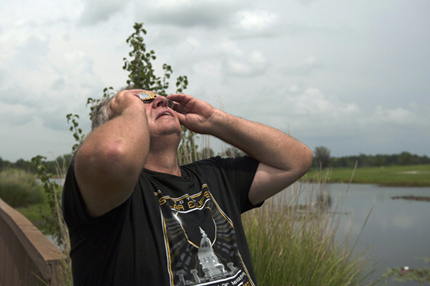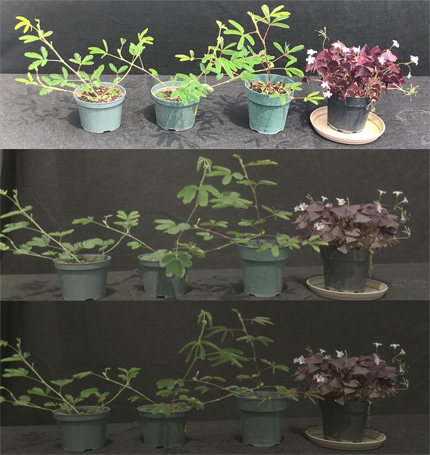5585 Guilford Road • Madison, WI 53711-5801 • 608-273-8080 • Fax 608-273-2021
www.agronomy.org
Twitter | Facebook
NEWS RELEASE
Contact: Hanna Jeske, Associate Director of Marketing and Brand Strategy, 608-268-3972, hjeske@sciencesocieties.org
Does eclipse equal night in plant life?
Dec. 13, 2017 - On August 21, 2017, about 215 million American adults watched one of nature’s most dramatic events: a total solar eclipse. However, most of the country could only see a partial eclipse. The path of the total eclipse was a strip just 70 miles wide, arcing across the country from Oregon to South Carolina.
 The University of Missouri-Columbia lies directly on that path of totality. Scientists there knew they had a once-in-a-generation opportunity to study how a total eclipse affects plants. During the event, there would be 45 minutes of gradually decreasing light. Temperatures would also fall. Next would be two minutes and 36 seconds of total eclipse: a span as dark as night and noticeably cooler. Light and warmth would then gradually return.
The University of Missouri-Columbia lies directly on that path of totality. Scientists there knew they had a once-in-a-generation opportunity to study how a total eclipse affects plants. During the event, there would be 45 minutes of gradually decreasing light. Temperatures would also fall. Next would be two minutes and 36 seconds of total eclipse: a span as dark as night and noticeably cooler. Light and warmth would then gradually return.
Tim Reinbott and colleagues at the university’s South Farm Research Center were curious to see how plants would react when night conditions interrupted the day. Would leaves fold up for the night? Would plants respond more to the change in light or the change in temperature? Would different kinds of plants respond differently?
“We were wondering if plants had a circadian rhythm—meaning that they have sensed when sunup and sundown are and have developed an internal clock, separate from sensing changes in light,“ Reinbott said. “So when we have totality of the eclipse in the middle of the day, would they even react?”
The team chose to observe four types of plants with different habits:
- Mimosa close their leaves at night and when they are touched.
- Oxalis (purple clover) close their leaves and fold their flowers at night.
- Drought-stressed soybeans fold up their leaves during the day and open them at night.
- Drought-stressed corn curls during the day and uncurls at night.
 The research team prepared two mimosa plants in advance by exposing them to either 72 hours of light or 72 hours of darkness. One mimosa was exposed to a normal light/dark cycle.
The research team prepared two mimosa plants in advance by exposing them to either 72 hours of light or 72 hours of darkness. One mimosa was exposed to a normal light/dark cycle.
The varied results have left the researchers with interesting questions.
Reinbott reported, “The regular mimosa responded to the eclipse by closing up its leaves, just like at sundown. But when we first exposed the mimosa plants to 72 hours of light or dark, they did not respond to the eclipse.” Reinbott thinks it may be because the light spectrum, some of which is undetectable to the human eye, had changes the plants may have responded to. “We have data that show slight differences in the light spectrum during totality and sundown. Possibly those plants exposed to 72 hours of light or darkness lost some of their photoreceptors for one of these wavelengths (blue and red/far-red).”
The oxalis responded very differently. It was a hot day, so the oxalis leaves were folded up to reduce sun exposure and retain water. As the eclipse started, the oxalis leaves opened up. After totality passed, the leaves closed again. But the oxalis did not fold its flowers as they do at dusk. “This shows that they have a circadian rhythm and were not fooled by the change in light from the eclipse. They only responded to the temperature change,” Reinbott concluded.
The drought-stressed corn did not visibly change much in response to the eclipse. Drought-stressed soybeans unfolded during the eclipse and then folded back up afterward, but it was unclear whether this was due to the temperature change or the light change. These soybeans behaved the same during totality as they do at sundown, showing they did not have a circadian rhythm.
Reinbott is looking forward to the next total eclipse over the same area in just seven years. In 2024 Reinbott and his team want to look more closely at plants’ photosynthesis and water management. They also hope to learn more about the role of the light spectrum and what triggers the circadian rhythm in plants.
Reinbott presented his research at the OctoberAnnual Meeting of the American Society of Agronomy, Crop Science Society of America, and Soil Science Society of America in Tampa, FL.